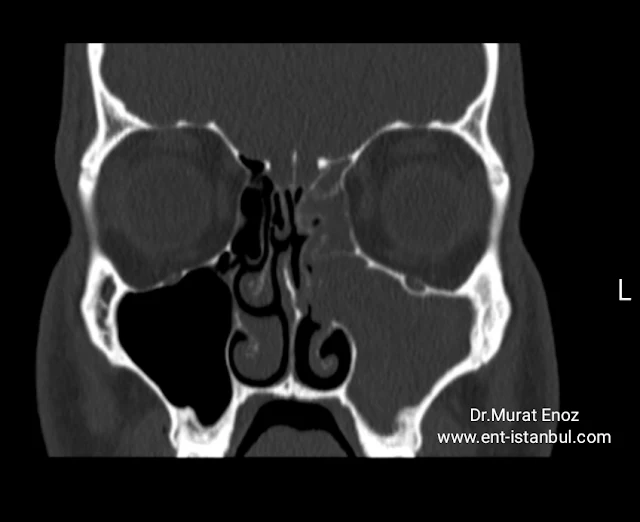Sinusitis
Sinusitis
or
rhinosinusitis is defined as an inflammation of the mucous
membrane that lines the paranasal sinuses. It can be due to
upper respiratory viral infection, allergy, nasal polyps,
deviated septum or autoimmune disases. Most sinusitis cases are
due to a viral infection and resolve over the course of 10 days.
Normally, sinuses are filled with air, but when sinuses become
blocked and filled with fluid, germs (bacteria, viruses, and
fungi) can grow and cause an infection.
Classification of sinusitis including:
- Acute sinusitis: Symptoms are present for 4
weeks or less. It is caused by bacteria growing in the sinuses.
A sudden onset of cold-like symptoms such as runny, stuffy nose
and facial pain that does not go away after 10 to 14 days.
- Subacute sinusitis: An inflammation lasting 4
to 12 weeks and represents a transition between acute and
chronic infection.
- Chronic sinusitis: Swelling and inflammation
of the sinuses are present for longer than 12 weeks. It may be
caused by bacteria or a fungus.
- Recurrent sinusitis: Several attacks within a
year (four or more acute sinusitis episodes that occur within
one year).
Acute Sinusitis
 |
| Acute Sinusitis |
Acute
sinusitis is defined as inflammation of the mucous membrane
of a sinus, especially of the paranasal sinuses for 4
weeks or less. It usually goes away without treatment. There are
various treatments that may help to ease symptoms. Antibiotics
are only sometimes needed.
Chronic Sinusitis
 |
| Chronic Sinusitis |
Causes of Chronic Sinusitis
The presence of the following diseases and conditions can cause chronic sinusitis:
- Nasal polyps, tumor and other space-occupying lesions in the nose
- Allergic reactions
- Nasal septum deviation
- Facial trauma (Broken facial bone may cause blockage of sinus passages)
Other medical conditions:
- Cystic fibrosis
- Gastroesophageal reflux
- HIV and other immune system related diseases
- Respiratory infections. (These infections can be viral, bacterial or fungal in nature.)
- Allergic diseases such as hay fever.
Signs and Symptoms of Sinusitis
 |
| Signs and Symptoms of Sinusitis |
Facial pain and pressure in the face along with a stuffy or runny
nose are the main symptoms of sinusitis.
Other common symptoms of sinusitis include:
Causes of Sinusitis
 |
| Sinusitis Causes |
Factors which can cause to developing sinusitis
include:
Diagnosis of Sinusitis
 |
| Sinusitis Diagnosis |
Acute sinusitis can be diagnosed with patient's symptoms and
endoscopic examination of the nose.
Complications of Sinusitis
 |
| Complications of Sinusitis |
Complications of sinusitis include acute and chronic sequelae.
Acute distant effects include toxic shock syndrome. Acute local
effects can also occur. Acute orbital complications include the
following: cellulitis, proptosis, chemosis, ophthalmoplegia, orbital
cellulitis, subperiosteal abscess, and orbital abscess. Other acute
complications include intracranial sequelae such as meningitis;
encephalitis; cavernous or sagittal sinus thrombosis; or extradural,
subdural, or intracerebral abscesses.
Treatment of Sinusitis
 |
| Treatment of Sinusitis |
Treatment of sinusitis include conservative preautions, medical
treatment surgical treatment.
Simple Suggestions That Can Be Done At Home For Sinusitis Treatment Applied by Our Grandparents!
Regarding the treatment of sinusitis, you can consider the following recommendations that you can apply at home, perhaps with regard to hot application and intranasal saline irrigation, which has been applied for many years. You can apply hot steam for 5-10 minutes by leaning over the container filled with hot water, putting the following herbs into the container, pulling a towel over your head:
- menthol and eucalyptus solutions (such as Vicks VapoRub or Buguseptil Solution sold in pharmacies)
- mint (dry or green fresh mint can be used)
- daisy
It is ideal for patients who are allergic to the plants listed here not to use these plants in steam application.
Applying hot steam to the face may be beneficial in the discharge of sinus secretions and in reducing pain, in addition to its antiviral and anti-inflammatory properties. Especially in patients with acute sinusitis attack, when there is facial pain and inflammatory nasal discharge, this application should be done 3 times a day and then irrigation of the nose with salt water (ocean water spray, sinus rinse, neti pot can be used). There are many beneficial effects of applying hot steam to the face, which has been known in Anatolia for a long time.
Apart from these applications, it is also beneficial to consume herbal teas orally and to increase the sleep time.
You can find more detail about endoscopic sinus surgery at >> www.ent-istanbul.com/2018/04/endoscopic-sinus-surgery.html
Murat Enoz, MD, Otorhinolaryngology, Head and Neck Surgeon - ENT Doctor in Istanbul
Private Office:
Address: İncirli Cad. No:41, Kat:4 (Dilek Patisserie Building), Postal code: 34147, Bakırköy - İstanbul
Appointment Phone: +90 212 561 00 52
Appointment Phone: +90 212 561 00 52
Fax: +90 212 542 74 47






Comments
Post a Comment